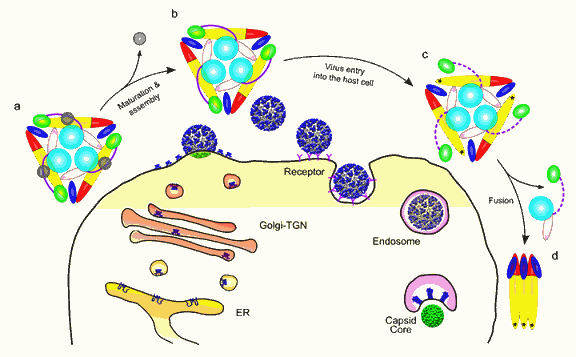The atomic-scale arrangement of proteins in a structure that enables a virus to invade and fuse with host cells, showing precisely how the structure morphs with changing acidity to initiate infection, has been determined by investigators using the U.S. Department Energy’s Advanced Photon Source at Argonne.
Findings from a team at Purdue University showed the protein structure in an acidic environment, and another team from the Pasteur Institute showed the same structure in a neutral environment. When combined, the two studies illustrate what happens to the structure as a virus enters and then prepares to fuse with a host cell, critical steps leading to infection.
"These findings represent a milestone," said Michael Rossmann, Purdue's Hanley Distinguished Professor of Biological Sciences, who is working with Long Li, a postdoctoral researcher in the Rossman lab, and Joyce Jose, a postdoctoral researcher in the laboratory of Richard Kuhn, a professor and head of Purdue's Department of Biological Sciences.
The study is aimed at learning precisely how viruses infect humans and other hosts, knowledge that may lead to better vaccines and antiviral drugs, Rossmann said.
Findings from the Purdue and Pasteur Institute studies are detailed in two papers appearing in the journal Nature on December 2, 2010.
The researchers studied alphaviruses, a family of viruses that includes eastern equine encephalitis and chikungunya viruses, which are transmitted by mosquitoes and sometimes ticks. The work focused on two "envelope proteins" making up 80 spikelike structures protruding from the outer shell of the viruses.
"The spikes have all the machinery for infecting a cell," Rossmann said.
Structural biologists have known the structure of envelop protein 1, or E1, for several years. The Purdue scientists have now determined the structure of envelope protein 2 and the precise atomic-scale architecture of the combined E1-E2 complex. Scientists had previously determined general characteristics about E2, such as its location in the protein complex, but they did not know its structure until now.
E2, a receptor-binding protein, enables the virus to initially attach to and enter host cells where the virus encounters an acidic environment that induces changes in the structure of the protein complex. These changes expose a portion of E1 required to fuse the virus with the cell membrane, leading to the formation of a "fusion pore" through which the virus's genetic material is transferred into the host cell. Once infected, the host cell then produces new virus particles.
The Purdue researchers learned the shape of E2's three "domains," showing how E2 displaces one of these domains when in an acidic environment, allowing fusion with the cell membrane. The scientists used advanced imaging technologies, including x-ray crystallography at the GM/CA-CAT beamline at the APS, and cryoelectron microscopy to uncover critical structural details about the viruses.
See: Long Li1, Joyce Jose1, Ye Xiang1, Richard J. Kuhn1, and Michael G. Rossmann1*, “Structural changes of envelope proteins during alphavirus fusion,” Nature 468, 705 (2 December 2010).
DOI:10.1038/nature09546
Author affiliation: Purdue University
Correspondence: *[email protected]
The research is funded by National Institutes of Health Grant P01 AI055672 to R.J.K. and M.G.R. Use of the Advanced Photon Source, an Office of Science User Facility operated for the U.S. Department of Energy (DOE) Office of Science by Argonne National Laboratory, was supported by the U.S. DOE under Contract No. DE-AC02-06CH11357.
Abstract on the research in this release, written by Emil Venere, is available from the Purdue University Newsroom at: http://www.purdue.edu/newsroom/research/2010/101201RossmannAlpha.html
The Advanced Photon Source is an Office of Science User Facility operated for the U.S. Department of Energy (DOE) Office of Science by Argonne National Laboratory. The APS is the source of the Western Hemisphere’s brightest high-energy x-ray beams for research in virtually every scientific discipline. More than 3,500 scientists representing universities, industry, and academic institutions from every U.S. state and several foreign nations visit the APS each year to carry out applied and basic research in support of the DOE mission to understand, predict, and ultimately control matter and energy at the electronic, atomic, and molecular levels in order to provide the foundations for new energy technologies and to support DOE missions in energy, environment, and national security. To learn more about DOE x-ray user facilities.
Argonne National Laboratory seeks solutions to pressing national problems in science and technology. The nation's first national laboratory, Argonne conducts leading-edge basic and applied scientific research in virtually every scientific discipline. Argonne researchers work closely with researchers from hundreds of companies, universities, and federal, state and municipal agencies to help them solve their specific problems, advance America's scientific leadership and prepare the nation for a better future. With employees from more than 60 nations, Argonne is managed by UChicago Argonne, LLC for the U.S. Department of Energy's Office of Science.

